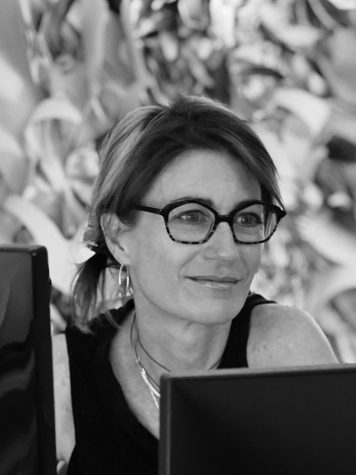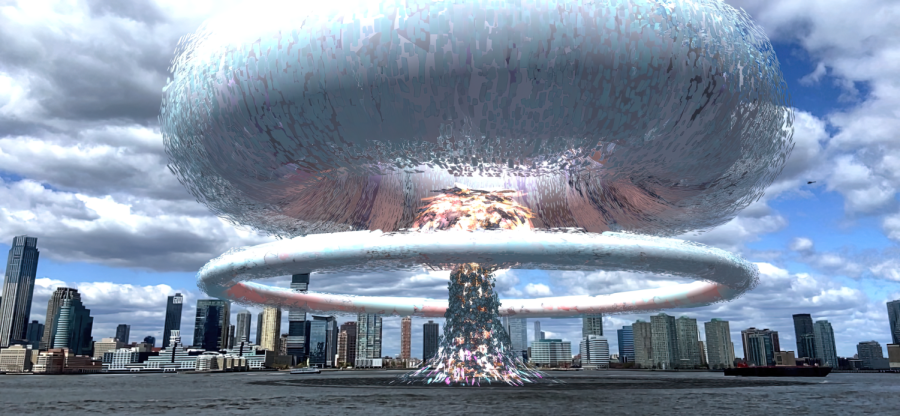Nancy Baker Cahill ’92 discusses intersection between art and virtual reality
December 7, 2022

“Mostly what I am is curious,” new media artist Nancy Baker Cahill ’92 said. “And I love learning from other people. I would say collaboration is the most immediate and rewarding path to that kind of learning, [because] understanding and the collective sharing of ideas is genuinely empowering.”
A 2021 Williams College Bicentennial Medal of Honor winner and 2022 Los Angeles County Museum of Art (LACMA) Art + Technology Lab Grant recipient, Cahill makes sure that collaboration, virtual reality, and social justice remain focuses of her installations. Many of these topics, she said, stem from her experience at the College.
Cahill, who transferred to the College as a sophomore, would have double majored in political science and art studio if she’d had the time to fulfill the requirements for both majors instead of just art studio. Still, the classes Cahill took in both disciplines proved equally instrumental in shaping her into the artist she is today, she said.
“The two most influential art classes I took were drawing and video,” Cahill said. “Those two disciplines ended up really shaping my career as it exists now… I was also very fortunate to be [taking] political science classes [with] a group of professors who were young, dynamic, and really innovative. I would say they had an outsized influence on my thinking [and] on shaping my critical approach not just to art making but also to a sense of civic engagement.”
Cahill also loved science fiction and was particularly interested in ideas of dystopia and protopia, a vision of positive societal transformation in which a state is better tomorrow than today — topics she engaged with during her political science classes. “In protopias, we can imagine better futures — we can imagine more equitable communities and societies,” she said. “ That was all embedded in part of my larger overall artistic literacy and passion.”
After graduating from the College in 1992 with a degree in studio art, Cahill worked a variety of jobs before engaging with the idea of creating a serious art practice in 2008. She described her time spent away from art as “deeply formative.”
“I think what happens when you take so much time off is that so much of that time off is spent longing for a certain, not just for a practice, but a way of being in the world, and a way of finding purpose and meaning,” she said. “When you do return to it, you really return with vigor. So when I jump-started my practice in 2008, it felt a lot like not just a train that had left the station, but a train that was going to forge ahead indefinitely.”
Many of Cahill’s first installations involved drawing, and she described the medium as her “first language, … [as] drawing led me directly back into digital.”
In 2012, Cahill created an immersive drawing series that elicited visceral reactions from many exhibition visitors. “That’s when I thought, ‘Oh, god, yeah, I really want to put people inside the drawings — how do I do that?’” she said. “That’s when my really wonderful curator said to me, ‘Why don’t you just make the drawings in [virtual reality]?’”
One such project Cahill then embarked on was 4th Wall, a free augmented reality art app and platform that challenges traditional conventions of public art and explores the possibilities of inclusive creation and expression. Cahill said that 4th Wall, which she founded in 2018 with Drive Studies, allowed her to digitally create art using a 360-degree canvas, opening a new portal into the power of collaboration, social justice, and immersive engagement. She continues to serve as the app’s artistic director.
Cahill explained that a major feature of her art includes looking critically at systemic power, and 4th Wall explores inclusive expression and greater conversation with public artists and non-artists. “The app has been an incredible platform and means through which [collaboration] has been possible,” she said. “I’ve had the enormous fortune to collaborate with hundreds of artists using this incredible tool — augmented reality.”
Cahill has since curated a variety of technological installations and projects around the globe, in places such as Los Angeles, Boston, and New York City as well as Austria, South Korea, and Switzerland, according to her website.
One of Cahill’s more recent installations was shown at Times Square’s July 2022 Midnight Moment, the world’s largest and longest-running digital public art program. The Midnight Moment synchronizes ninety-two digital displays on a stretch from 41st Street to 49th Street in Manhattan to share an artist’s work from 11:57 p.m. to midnight every night, according to its website.
Cahill’s Midnight Moment installation, titled “Slipstream Times Square,” began as graphite drawings that she tore apart and assembled into sculptures. She then documented the pieces using photogrammetry, a digital artifacting process that surveys measurements and properties of digital art, which provided new additive and subtractive elements to the work. She also used three-dimensional software such as AfterEffects to continue to light and animate the pieces.
Cahill described both creating and watching her Midnight Moment in Times Square as “an extraordinary experience.”
“At this point, I was no stranger to immersive architectures, immersive experiences, and that’s quite a stage — 90 screens in 360 [degrees] is no small thing,” Cahill said. “How are you going to use those three minutes to have the greatest impact? What I realized is I really wanted to dissolve the screens in the same way that [augmented reality] allows us to play in that in-between space and dissolve certain boundaries and interfaces, but I wanted to do the same thing with screens. To do that, I created a piece that was intended to feel pulsing and alive, and like it almost threatened to spill out from the surfaces.”
Cahill was concerned that the installation might make viewers seasick, but she said she believed her design would be the best method to interrupt and replace the relentless, visual noise of Times Square ad space with something more transcendent. She also wanted viewers to envision that they were placed within a living, pulsating body, and accordingly chose hot pink as the installation’s main color.
“All of Times Square just ended up being bathed in this hot pink light,” Cahill said. “It was wild watching everybody react to it in these different ways, and it cast a spell.”
Cahill said quantifying the amount of time spent on creating such an enormous installation was difficult, given the amount of precision required to produce such multimedia work.
“I think one of the things that people who aren’t familiar with digital art don’t understand is that the labor involved in digital art is so collaborative,” she said. “Obviously, it’s you and the computer. But the labor to create digital art is every bit as rigorous as the labor to create anything analog, and, arguably, sometimes more so. I feel I’ve learned so much software over the years, and sometimes just sitting down with a pencil and a piece of paper is the greatest relief.”
Despite these challenges, Cahill is excited to continue to engage with multimedia installations in the future. She will begin a residency in London this January.
“I think that interdisciplinary collaboration is going to yield a whole new universe — not just of problem solving, but also of creative output and cultural engagement,” Cahill said. “I’m really excited to continue to really push myself in terms of what I can imagine and learn and execute.”









